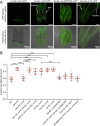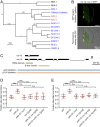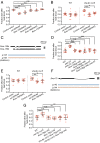A cullin-RING ubiquitin ligase promotes thermotolerance as part of the intracellular pathogen response in Caenorhabditis elegans
- PMID: 32193347
- PMCID: PMC7148578
- DOI: 10.1073/pnas.1918417117
A cullin-RING ubiquitin ligase promotes thermotolerance as part of the intracellular pathogen response in Caenorhabditis elegans
Abstract
Intracellular pathogen infection leads to proteotoxic stress in host organisms. Previously we described a physiological program in the nematode Caenorhabditis elegans called the intracellular pathogen response (IPR), which promotes resistance to proteotoxic stress and appears to be distinct from canonical proteostasis pathways. The IPR is controlled by PALS-22 and PALS-25, proteins of unknown biochemical function, which regulate expression of genes induced by natural intracellular pathogens. We previously showed that PALS-22 and PALS-25 regulate the mRNA expression of the predicted ubiquitin ligase component cullin cul-6, which promotes thermotolerance in pals-22 mutants. However, it was unclear whether CUL-6 acted alone, or together with other cullin-ring ubiquitin ligase components, which comprise a greatly expanded gene family in C. elegans Here we use coimmunoprecipitation studies paired with genetic analysis to define the cullin-RING ligase components that act together with CUL-6 to promote thermotolerance. First, we identify a previously uncharacterized RING domain protein in the TRIM family we named RCS-1, which acts as a core component with CUL-6 to promote thermotolerance. Next, we show that the Skp-related proteins SKR-3, SKR-4, and SKR-5 act redundantly to promote thermotolerance with CUL-6. Finally, we screened F-box proteins that coimmunoprecipitate with CUL-6 and find that FBXA-158 and FBXA-75 promote thermotolerance. In summary, we have defined the three core components and two F-box adaptors of a cullin-RING ligase complex that promotes thermotolerance as part of the IPR in C. elegans, which adds to our understanding of how organisms cope with proteotoxic stress.
Keywords: C. elegans; cullin-RING ubiquitin ligase complex; heat shock; intracellular pathogen response; proteostasis.
Conflict of interest statement
The authors declare no competing interest.
Figures







